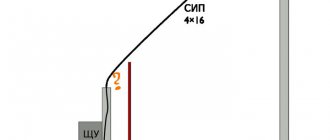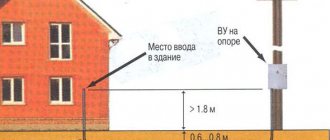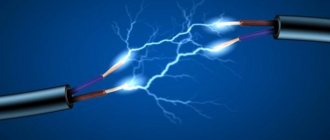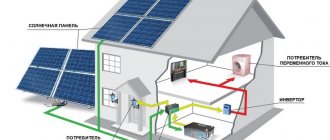It is unlikely that the site will be used for its intended purpose without communications connected to it. And the first thing the owner will need is electricity. It is also possible to supply electricity to a site without buildings. This procedure requires a careful approach, as it involves installing networks, performing a number of design work and approvals. The land owner will have to take into account the load on the networks, based on projected consumption needs and other technical issues.
The absence of buildings on the site will not be a reason for refusing electricity. However, approval of the project and technical conditions are considered mandatory.
Legal regulation
When conducting electricity to the territory of your own site, you must be guided by the current legislation of the Russian Federation. So, among the main rules that need to be taken into account:
- Federal Law No. 35-FZ of March 26, 2003 “On the Electric Power Industry” defines fundamental issues. The law talks about the conditions of access to electrical networks and connection to them;
- Decree of the Government of the Russian Federation of December 27, 2004 No. 861 establishes the rules for connecting new subscribers to electrical networks.
You also need to be guided by technical norms and standards that determine specific connection conditions in each specific case.
Electrification under the federal program
Sometimes you can hear mention of the federal program for the electrification of garden partnerships, individual housing construction plots and other land plots. Sources have different interpretations of the content and conditions of this program. They have one thing in common - supposedly preferential connection conditions, under which you can arrange electrification of a plot, cottage, household or other property for only 550 rubles.
However, 550 rubles is the standard cost for connecting individuals using up to 15 kW for domestic purposes, provided that the nearest distribution station or power pole is located within a radius of 300 (500) m from their site. The specified amount applies to all consumers who fall under these conditions.
As for preferential electrification programs, there are no such programs at the federal level. However, they may well exist at the regional level. For example, in the Yaroslavl region, since 2013, the Program for the consolidation and restoration of the power grid complex of gardening partnerships has been in effect.
What is needed to conduct electricity
In order to conduct electrical communications to your own site, you need to perform a number of actions in the following order:
- Visually find a nearby electrical network. It is best if it is a 380 volt network, which looks like 4 conductors on poles. If such a line is not detected, then a 6 kV network may be located nearby, which looks like 3 conductors on more “solid” poles.
- Determine the owner of the electrical network. First of all, you should ask your neighbors about this, especially those who have recently dealt with a similar issue.
- Contact this organization and apply for connection.
- Conclude a service agreement with the organization.
You can find the necessary information on the Internet. It is better to search at the address where the land plot is located, which will help you find an organization engaged in the sale of electricity in a certain territory.
Each site is serviced by one company. Difficulties can arise only when the plot is located on the border of the service areas of two electricity supply companies. In this case, you need to contact the organization whose pillar is closer.
When submitting an application, you need to find out whether there are technical conditions for connection. You can clarify the information only with the organization that will be involved in the sale of electricity.
Check and connection procedure
After submitting an application, signing an agreement and fulfilling his part of the technical conditions, including laying cables across the allotment, the owner must notify the network organization. This can be done in your personal account on the supplier’s website, by mail or by contacting us.
At this stage, the applicant submits an agreed electrification project and technical data sheets of the equipment. The further procedure for connecting electricity to the land plot requires verification of compliance with the conditions of the technical specifications and inspection of the equipment.
Representatives of the network organization agree with the owner on the inspection time. Having visited the land plot, they conclude that the installation work complies with the technical conditions. If there are any discrepancies, specialists will provide the owner with information about the violations and recommendations for eliminating them. If the work is carried out correctly, the following acts are drawn up:
- electrical equipment inspections;
- on the implementation of specifications agreed with the energy system operator;
- on technological connection;
- approval of the electric meter for operation;
- delimitation of the boundaries of balance sheet ownership;
- operational responsibility of the parties.
These documents are issued free of charge; any requirement to pay a fee for their issuance is illegal.
After this, the applicant enters into a power supply agreement. For those who are interested in how to conclude a contract for electricity supply, we will suggest two ways:
- Sign an agreement with the energy sales company, which undertakes the supply and settlement of the issue with the network organization in the interests of the applicant.
- Sign an agreement on the provision of electricity supply services with the network company and an electricity purchase and sale agreement with the energy sales office.
Only after contracts are signed is the use of the power grid legal. The process may take 4-6 months.
Required documents
After identifying a company engaged in the supply of electricity, you need to take from it a list of documents required for filing an application. In each individual case, the specific package may differ, but most often it consists of:
- applications. Most often it is drawn up according to the presented sample;
- copies of the document identifying the applicant. The most commonly used is a passport;
- title documents for the site, for example, extracts from the Unified State Register, etc.;
- copies of TIN;
- list of planned energy-consuming devices;
- calculating the expected load;
- plan of the site and buildings on which the location of power poles will be located.
Download an application for connecting electricity to a land plot (sample)
It is best if the calculation and plan are drawn up by trusted specialists, since such work requires a professional approach.
You can send documents by mail or hand them over in person. The response must be sent to the applicant within a period not exceeding 30 days.
Contents of the response to the connection request
If the decision is positive, the response will contain two copies of the contract, as well as technical connection conditions.
The contract must contain a deadline for completing the work. The maximum is six months, most often it is written in the sent copies. However, the actual duration depends on how close the power lines are. If you have to draw electricity within the city, and the distance is up to 300, and in rural areas up to 500 meters, then there will be no difficulties.
At the end of six months, the applicant has the right to contact the company with claims, as well as the relevant authorities with complaints. If the distance is large, you can try to wait a little longer, since the lack of results may be caused by technical difficulties. However, no one is required to wait additional time beyond the specified period.
Paperwork
To connect a site without buildings to electrical networks, a standard package of documents is required.
It includes:
- the applicant's civil passport;
- a certificate confirming the applicant’s ownership of the land plot;
- plan diagram of the territory of the land plot with the designation of the nearest power line poles;
- plan diagram of the territory of the land plot indicating the location of utilities.
If documents are submitted by a third party, a power of attorney to perform the relevant actions must be attached to the list of main papers. Based on the submitted documents, the network organization will issue technical conditions according to which all further work will be carried out.
Connection cost
One of the most popular questions from potential consumers concerns the cost of connecting to the electrical grid.
Guided by Government Decree No. 129 of 2011, if the distance is up to 300 meters in the city and up to 500 in rural areas, and the power consumption is up to 15 kW, then the price will be only 550 rubles. In situations where distance or power exceeds the established parameters, prices will increase significantly as they will be calculated using commercial standards. For example, in the Moscow region, for each kW you will need to pay an additional about 10,000 rubles, that is, for 20 kW you will have to pay about 200,000 rubles.
Before purchasing a plot, it is recommended to pay attention to how far away the connection point is located. If it is more than the established distance of 300 or 500 meters, then you need to immediately calculate the approximate costs of connecting communications, including electricity.
If a company requires additional contributions to carry out work when the distance and power meet the standards, there is no need to pay for this, no matter how the organization justifies its expenses. The cost should be 550 rubles and no more.
Connection costs
The issue of the cost of technological connection is especially acute for private consumers of electricity. This is due to the dishonesty of network operators, who impose unjustified specifications and huge amounts of connection fees on applicants.
In reality, how much it costs to install light on an area depends on:
- requested power;
- distances from the land plot to the nearest distribution facility: pole, substation, and so on;
- number of power supply sources;
- technical conditions required for connection.
For individuals, a fixed connection cost of 550 rubles is established under the following conditions:
- the nearest distribution facility is within a radius of 300 m from the site (500 m for rural areas);
- power volume less than 15 kW;
- number of supply sources – no more than one (clause 17 of the Technological Connection Rules).
However, the indicated amount is only the cost of the actual connection, that is, laying the cable to the boundaries of the site. The rest of the costs for electrical wiring throughout the site, arrangement of electrical towers and metering devices, preparation of project documentation and other mandatory activities are borne by the applicant.
As a result, even if the minimum tariff for electrification is applied, costs can amount to 5-50 thousand rubles. In each case, the amount of costs is determined individually.
Further steps to connect to electricity
After obtaining permission and technical conditions, it is necessary to prepare an electrification project. You can do it yourself, but in the absence of special technical knowledge, this will be problematic. It is recommended to contact a specialist or order one from a resource supply company that carries out the relevant work.
The actual connection can also be done by specialists. You will need to install the meter on a special pole. And the connection to the network will be made by employees of the resource supply company, who will also seal the meter and draw up an act on connecting the new subscriber to the network.
Connection procedure
To make it clearer to you where to start in order to install electricity on your own plot of land, we will divide the actions into two stages: organizational measures (collecting documents, submitting an application, etc.) and technical ones (in particular design and electrical installation work).
Getting permission
Organizational arrangements involve the submission of a package of documents to the energy supply organization, such as:
- A copy of the passport of a citizen of the Russian Federation - the owner of the site (if the application is submitted by another person, a power of attorney is attached).
- A copy of the document confirming ownership of the house or summer cottage.
- A plan diagram of the site with the location of power receiving devices and indicating the nearest power transmission line support, as well as indicating the exact location of all engineering systems on the site, including gas pipelines and water supply pipes.
- Single-line diagram of the applicant's electrical networks.
- Consent to the processing of personal data (in accordance with the requirements of the Federal Law “On Personal Data” No. 152 of July 27, 2006.
It is better to clarify the list of required documents and the procedure for their execution and submission in the Distribution Zone.
Plot data can be provided from a public cadastral map, in which a plot can be found by the cadastral plot number indicated in the title deeds.
There is a point that if the pole from which you can connect electricity is located further than 25 meters from the border of the site, then in order to provide light to the site, you will have to install an additional pole, and most likely at your own expense.
If everything is in order with this and the distances are within normal limits, there will be no difficulties, and following our recommendations you will be able to conduct electricity to the site. Based on these documents, the energy supply company must issue technical conditions, thanks to which you can already install light.
According to Decree of the Government of the Russian Federation No. 861 dated December 27, 2004 (clause 12), the energy supplying organization does not have the right to refuse you, and if it is not possible to connect electricity on time, for technical reasons, inform the deadlines for their implementation. This may be a lack of technological connectivity, this line is operating at the limit of its capabilities, and the connection of a new subscriber will lead to an accident in the network. And in order to bring light to your home, you need a partial or complete modernization of the power supply network, which can take years of waiting.
If the answer is positive, in a month you will have in your hands a document, a connection agreement and technical conditions, with an allowed power of up to 16 kW (for a country house and a residential building they differ), the name of the electricity meter, the input switch, the RCD protective device and the sealed box for outdoor installation.
By the way, you can save a lot of time running around the authorities and do what you love at this time if you submit an application for home electrification via the Internet on the website “https://portal-tp.rf”. In short: register, submit an application, attach copies of the documents described above, there is also the possibility of a preliminary application with a calculator, indication of the bill amount for connecting to the electrical network. In other words, on this site you can find out what documents are needed in order to provide electricity to a site, even if it has no buildings, as well as how much it will cost to electrify the site.
Technical events
We take the technical specifications and go to a specialized electrical goods store. We purchase a meter, machines, a sealed box for external installation of an electricity meter.
We go to our personal plot, install the box on the outer wall of the house or a prepared support, make switching in the box in accordance with the PUE and the diagrams in the technical specifications, or a specialist will carry out the electrical installation for a fee.
Then the wires from the street box need to be routed to the switchboard in your home (the article assumes the presence of ready-made electrical wiring for turning on the light, or a prepared switchboard with an RCD and automatic circuit breakers in the room). If the metering board is on a separate support, far on the border of your personal plot, you can run the cable in the ground in a trench to the house being electrified. We talked in detail about how to install electrical wiring underground with your own hands.
The connection of electricity from the pole to the subscriber's input panel will be made by the company's specialists, who will also seal the meter and draw up a subscriber connection certificate. The layout and installation of electrical wiring must be carried out in accordance with current standards and regulations in compliance with safety precautions.
It is imperative that you also install a protective grounding circuit; in our age of technology and electrical devices, this would not be superfluous at all. We talked about how to make grounding in a private house in the corresponding article.
Additionally, we recommend watching a video that shows how to connect the light from the pole to the house:
Supply of electricity to the panel
Connection refusal and further actions
Network connection may be denied for the following reasons:
- not a complete package of documents has been submitted;
- the plan and list are drawn up incorrectly;
- documents were submitted to a company servicing a territory other than the declared one;
- there is no technical possibility.
In case of refusal, you can eliminate the reasons for the negative decision or go to court to appeal the actions or inaction of the organization.
Connecting a plot without buildings to the electrical network is carried out in exactly the same way as connecting a plot with buildings. It is necessary to perform a series of sequential actions, as well as identify and ensure technical feasibility. The cost of connection, if the established standards are not exceeded, will be only 550 rubles, but if the distance is exceeded, you will need to pay additionally for each unit of potentially consumed power and additional distance for connection.
Read: Privatization of leased land
Consequences of unauthorized connection of electricity
The described connection procedure, although it involves many difficulties and expenses, is the only legal one. Its violation is fraught with undesirable consequences for the owner:
- Unauthorized supply of electricity to a land plot is almost impossible to legitimize; it is easier to dismantle the extended networks and carry out the process of technological connection.
- Unauthorized connection, in accordance with the Regulations, approved. , is interpreted as “non-contractual electricity consumption”. In this case, the consumer is obliged to compensate for the damage by paying for the estimated amount of electricity used. The calculation takes into account the maximum throughput of the supply cable, multiplied by 24 hours and multiplied by the period counted from the date of the last control check, but not more than 3 years. Compensation will be equal to the cost of electricity that the offender would have consumed for 3 years if he had used electricity at the maximum capacity of the power cable around the clock.
- Unauthorized connection entails administrative liability under Art. 7.19 and for individuals is punishable by a fine of 10-15 thousand rubles. In addition, there is a practice of bringing illegal consumers to criminal liability under Art. 165, according to which violators can be fined in the amount of up to 300 thousand rubles or 2 years’ salary, or they can be subject to forced labor and other types of punishment, up to imprisonment for up to 2 years.
Given the existing risks, the cost of electrifying sites may not seem so large.
Requirements for an electrification facility
For a single-phase line, use a cable with a cross-section of at least 16 mm² (aluminum) and 6 mm² (copper). Be sure to choose wiring with reliable insulation. All inputs are provided with control devices (meters) and input and distribution installations in accordance with the design papers.
Rules for organizing wiring:
- The distance from the common highway to the consumer connection point in a straight line should not be more than 300 m (for standard connections). In non-standard cases, the project provides for the reconstruction of power lines to connect to the plot.
- The standard connection power is not allowed by regulations to exceed 50 kW. In non-standard options, more is allowed, but it will require re-equipment of the facility with the preparation of the necessary documents and drawings.
- A safe gap is provided between the supply cables: 50 mm is enough for brick walls, 100 mm is enough for vertical wood fences.
- If the site is more than 25 m from the nearest connection support, additional poles are installed.
- The height of the wall entry from the ground is provided for at least 2.75 m, and the height distance from the window opening is at least 1.5 m.
The owner of the site is obliged to maintain good condition of protective equipment, emergency devices, and metering devices. The consumer complies with the technological connection requirements.
Methods for supplying electricity to the site
For this purpose, overhead and underground laying is used.
In the first option, cables of the brand are used:
- AVK with aluminum core;
- SIP-4 - heat-resistant wire with durable polyethylene insulation;
- AVVG - copper or aluminum.
Underground installation is done with wires:
- AVBbShv - high strength with aluminum core;
- VBBShv - similar to the previous one, only with a copper core.
Underground cables must have a cross-section of at least 10 mm², and the trench depth must be at least 75 - 85 cm (wire in a pipe), and 1.0 m (wire in the ground without a pipe).











